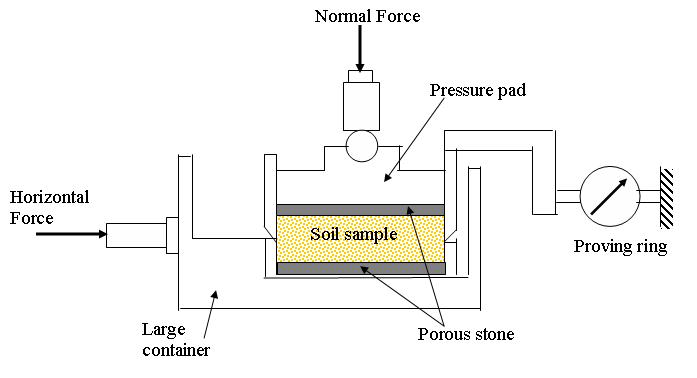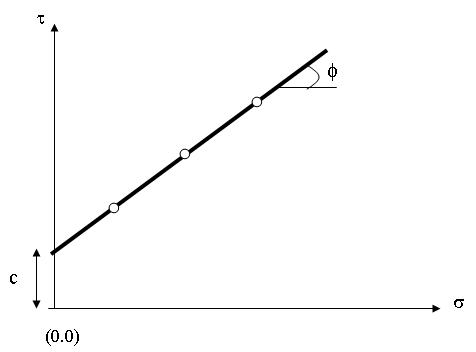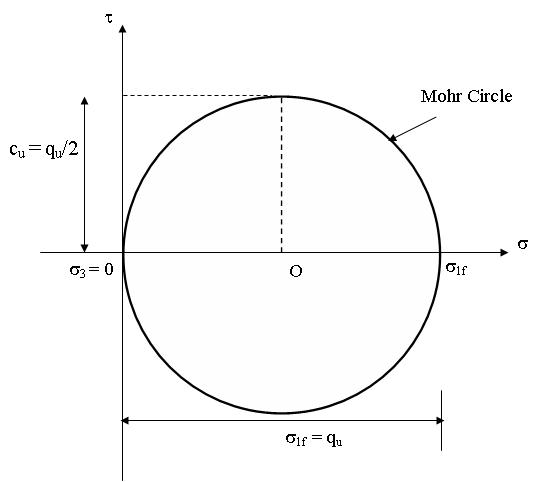Site pages
Current course
Participants
General
MODULE 1. Fundamentals of Soil Mechanics
MODULE 2. Stress and Strength
MODULE 3. Compaction, Seepage and Consolidation of...
MODULE 4. Earth pressure, Slope Stability and Soil...
Keywords
29 March - 4 April
5 April - 11 April
12 April - 18 April
19 April - 25 April
26 April - 2 May
Lesson. 11 Strength Parameters of Soil
11.1. Determination of Strength parameters
The shear strength parameters cohesion (c) and friction angle (Φ) can be determined by different laboratory tests for different types of soils.
Direct shear test:
The soil sample is tested in a confined metal box of square cross-section. The box has two halves horizontally and a small clearance is maintained between them. Figure 10.1 shows a direct shear test set-up. Upper half of the box is fixed and lower half of the box is pushed or pulled horizontally with respect to the fixed half. Thus, a shear is applied in the soil sample. A constant normal force (vertical) is applied on the sample throughout the test. Then horizontal force or shearing is applied till the failure. The shearing is normally applied at a constant rate of strain. The amount of shear load is measured with the help of proving ring. The vertical as well as horizontal deformation is measured with the help of dial gauges. The test procedure is repeated for different normal stresses (four to five normal stresses). The shear stress at failure is plotted against different normal stresses (as shown in Figure 11.2). The shear strength parameters are determined from the best-fit straight line passing through the test points (as shown in Figure 11.2). The test is suitable for sandy soils. If the sample is partially or fully saturated, porous stones are placed below and top of the sample to allow free drainage. Figure 11.3 shows typical shear stress-shear displacement and change in height of sample-shear displacement plot of soils obtained from direct shear tests.

Fig. 11.1. Direct shear test

Fig. 11.2. Shear stress-normal stress plot

Fig. 11.3. Shear stress-shear displacement and change in height of sample-shear displacement plot of soils obtained from direct shear tests.
Unconfined compression test
The test is suitable for saturated clay (Øu =0). The test is conducted under zero cell pressure. Thus, it a special case of triaxial test with σ3 = 0 (triaxial test is described in lesson 12). A cylindrical specimen is subjected to axial stress until failure. Figure 11.4 shows the Mohr circle for unconfined compression test. For purely clayey soil, Øu =0, the subscript u is used as the test is undrained test. The major principle stress (σ1) is equal to the unconfined compressive strength of the soil (qu).

Fig. 11.4. Mohr-Coulomb plot for an unconfined compression test on saturated clay.
The undrained cohesion can be determined as:
 .............................................................................................(11.1)
.............................................................................................(11.1)
For determining the unconfined compressive strength of the soil (qu) (the applied load at failure divided by the cross-sectional area of the sample), the cross-section of the soil sample at failure load (Af) is determined as:
 ...........................................................................................(11.2)
...........................................................................................(11.2)
where A0 is the initial cross-sectional area of the sample and e is the axial strain in the sample. The strain in the sample can be determined as:
\[\varepsilon=\frac{{Change\;in\;length\;(\Delta L)}}{{Initial\;length\;of\;the\;sample\;(L)}}\]........................................(11.3)
The usual sizes of the samples are: 76 mm (length) x 38 mm (diameter) or 100 mm (length) x 50 mm (diameter).
References
Ranjan, G. and Rao, A.S.R. (2000). Basic and Applied Soil Mechanics. New Age International Publisher, New Delhi, India
PPT of Professor N. Sivakugan, JCU, Australia
Suggested Readings
Ranjan, G. and Rao, A.S.R. (2000) Basic and Applied Soil Mechanics. New Age International Publisher, New Delhi, India.
Arora, K.R. (2003) Soil Mechanics and Foundation Engineering. Standard Publishers Distributors, New Delhi, India.
Murthy V.N.S (1996) A Text Book of Soil Mechanics and Foundation Engineering, UBS Publishers’ Distributors Ltd. New Delhi, India.